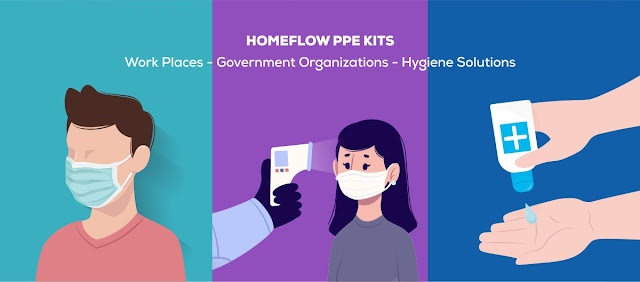MASKS AND CORONAVIRUS: THE HOMEFLOW EXPRESS GUIDE
It’s 2020 and Covid-19 has a grip on the world. Face masks are in high demand. Along with healthcare professionals, the public are receiving conflicting advice on wearing masks to go about their day to day business. But how do we know what masks are suitable for different environments? Here’s Homeflow’s guide to face masks!
What kind of masks actually protect against Covid-19?
There is some confusion about the difference between the FFP masks and the surgical masks. There is a clear difference between a surgical mask and a respirator, so here is a summary.
Surgical masks and surgical respirators vary in intended use, fit against the face and required testing and approval standards.
Surgical masks
A Type II (or Level 2) surgical mask is what you might think of as a “regular” mask used in day to day practice. Type II is a European standard that’s equivalent to the American standard Level 2. Type IIR are fluid resistant masks.
Type II surgical face mask
These masks are loose fitting, cover the nose and mouth, and are intended first to protect the patient and working environment from bacteria shed in liquid droplets and aerosols coming from the wearer’s nose and mouth. To some extent they also protect the wearer’s face from possible splashes of potentially contaminated liquids.
They are not sized for individual fit and so will not pass a fit test. They’re single use, for a maximum of 2-3 hours, and should be discarded when contaminated with blood or other bodily fluids. They must be disposed of as clinical waste.
Surgical masks or medical face masks are classified as class 1 Medical Devices under the Medical Devices Directive 93/42/EEC. They are intended to be used in operating theatres and healthcare settings with similar requirements.
In Europe, surgical masks must bear a CE-mark and comply with the requirements defined in EN 14683 “Medical face masks – requirements and test methods.” on the construction, design and technical performances.
The version of EN 14683:2014 includes 4 tests to classify the masks in 3 types:
1) Bacterial Filtration Efficiency (BFE)
The BFE measures the percentage efficiency at which the face mask filters bacteria passing through the mask.
2) Breathing Resistance (Delta P) or the Differential Pressure
This test determines the air permeability of the mask, and determines its “breathability”. It is measured by determining the difference of pressure across the mask under specific conditions of air flow, temperature and humidity. The lower the delta P of the medical face mask, the better and easier it is for the wearer to breathe through it.
3) Splash Resistance (ISO 22609)
The splash test measures the fluid resistance of the mask.
4) Microbial Cleanliness (EN ISO 11737-1)
“Cleanliness” of the medical face mask is defined by freedom from population of viable micro-organisms on a product and/or a package. The standard stipulates that the medical face mask must be tested according to the EN ISO 11737-1 standard which provides guidance for the enumeration of the viable microorganisms on a medical device, also referred to as “bioburden”.
Valved vs Non-valved Respirators
Valved respirators make it quicker and easier to exhale air compared to non-valved respirators, so may be more comfortable to wear. Also less moisture tends to build up inside the respirator. However they can also let particles out from the wearer into the air without filtering, so clinical judgement should be used when deciding what type of respirator to wear.
They are single use and should be discarded when wet or visibly dirt, damaged or deformed, when they no longer form an effective seal to the face, when breathing becomes more difficult, or when contaminated with blood, respiratory or nasal secretions, or other bodily fluids.
Whats the difference between Type I and Type II Masks?
Type I, and Type I R face masks have a BFE (bacterial filtration efficiency) of 95%, whereas Type II and Type II R face masks have a BFE of 98%. The breathing resistance for Type I R and Type II R masks, are exactly the same as the standard types with the ‘R’ simply denoting that they are also splash resistant.
Type I, I R, II and II R face masks are medical masks tested in the direction of exhalation (inside to outside) and take into account the efficiency of bacterial filtration. Surgical masks of this type help stop the wearer from infecting the surrounding environment. They are not effective at protecting the wearer from airborne viruses such as Coronavirus.
What is a Type II Face Mask?
Type II face masks (EN14683) are medical face masks made up of a protective 3 ply construction that prevents large particles from reaching the patient or working surfaces, however they are not effective when blood or bodily fluids are present.
Characteristics of Type II face masks include:
Pleat style with ear loops or ties
Protective three-layer construction
Available in a variety of colours and styles
What is a Type IIR Face Mask?
Type IIR face masks EN14683 are medical face masks made up of a 3 ply construction that prevents large particles from reaching the patient or working surfaces. Type IIR Face masks include a splash resistant layer to protect against blood and other bodily fluids. Type IIR face masks are tested in the direction of exhalation (inside to outside) and take into account the efficiency of bacterial filtration.
Characteristics of Type IIR face masks include:
Pleat style with ear loops or ties
Protective three-layer construction
Available in a variety of colours and styles
Splash resistant layer against bodily fluids
Type I, Type IR, Type II and Type IIR masks are for use in protecting others from the wearer transmitting infection.
What’s the difference between FFP2 & FFP3 Face Masks?
FFP2 & FFP3 Face Masks are European classes of respirators, tested on the direction of inhalation (outside to inside) and take into account leakage to the face and filtration efficiency.
FFP2 face masks are the equivalent of N95 face masks, which meet the guidelines from The World Health Organisation for protection against Covid-19. FFP2 masks have a minimum of 94% filtration percentage and a maximum of 8% leakage to the inside. These masks are held tightly in place by the elastic earloop or head strap and have a typical lifespan of 3-8 hours depending on environmental factors.
FFP3 face masks are the most effective at filtration, with a minimum filtration of 99% and a maximum leakage of 2% to the inside. These masks are shaped to your face for a tight fit and some types have a valve to help breathe as the filtration material is thicker. The valve also reduces the build up of moisture, lengthening the lifespan of the mask. FFP3 masks are typically used for handling asbestos.
FFP2, FFP3, N95 and other respirator masks are effective at protecting the wearer from viral transmission.
It should be noted that N95 and KN95 masks can not normally be officially legally recommended for use in Europe although in the current situation with PPE shortages in practice a more flexible approach seems to be being taken with N95 masks.
For more information on suspicious certificates for PPE click here.
3 ply mask manufacturers in United Kingdom




3m 1860 n95 mask
ReplyDelete